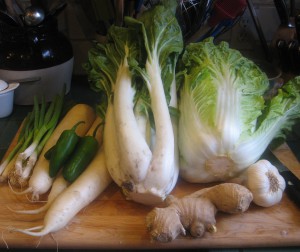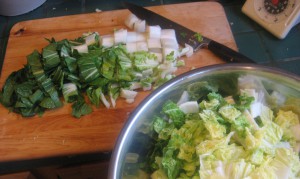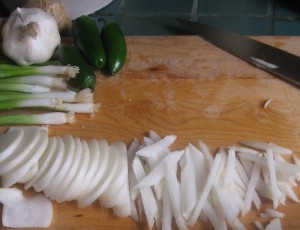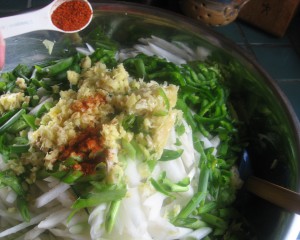Simple Bone Broth
Ingredients:
- Bones, skin, feet and non-liver organs of chickens or other meat. Or a whole chicken.
- 1/4 – 1/2 cup lemon juice or apple cider vinegar per gallon total volume of bones and water
Directions:
If using bones from a red meat animal, roast the bones at 350 degrees for one hour until browned and caremelized. This is not necessary for poultry.
Crack the bones if you can, using the bottom of a heavy pot (optional). Place bones and lemon juice or vinegar in a pot or slow cooker. Add water just to cover. Soak the bones for at least an hour in the cold acidulated water.
Bring to a boil and skim off any foam that rises to the top. Turn down to a low temperature. Ideally there should be barely any bubbles rising, hardly any movement in the simmer. The slow cooker on low may even be too hot, but I use it anyway, it’s so easy.
Cook for 6 – 12 for poultry, 24 – 72 hours for larger animals (red meat). If using a whole chicken, remove the chicken after cooking an hour or two and pull the meat from the bones to use in other recipes. Return the bones and skin to the broth and continue cooking. The longer the broth cooks, the more minerals will leach into the broth, making it a rich mineral supplement. Sometimes the gelatin breaks down with the longer cooking with the poultry or with the higher heat, so you might lose that benefit. The bones should be crumbly to the touch, at least at the ends.
Another method is to cook the bones for eight hours. Strain and reserve broth. Add water and acid to the bones again, and cook eight more hours. Repeat, if you have the patience. Each successive batch will be less gelatinous, more neutral in flavor, and rich in minerals.
Optional – Bring finished broth to a boil, simmer, and reduce by half. Cool. Pour into ice cube trays and freeze. Pop the broth cubes into a zip lock bag and store in the freezer. Use in sauteeing veggies, pop a few in when cooking grains, and, of course, dilute a bit for soups. If you’ve reduced it, remember it’s concentrated. Especially if you’ve used a lot of chicken feet! They make a very dense broth.







